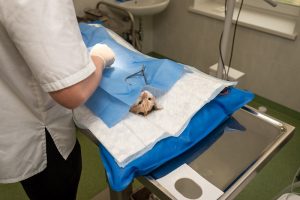Many pet owners may be nervous to put their pets under anesthesia for elective or even necessary procedures. We understand as your veterinary team the reservations you may have with this as a pet owner. Our goal is to educate you so that you understand the measures we have in place to keep your pets safe! These include pre-anesthetic exams, ensuring internal organ function, qualified staff working with your pets, monitoring equipment and safety checks.
have in place to keep your pets safe! These include pre-anesthetic exams, ensuring internal organ function, qualified staff working with your pets, monitoring equipment and safety checks.
What is included in a pre-anesthetic exam? If your pet has not been seen with us in the past year, we will set up an appointment for a head to tail exam with a doctor. At this time, they will check heart and lung function, feel for and changes in the abdomen, look at gum color and hydration level and more. This helps us determine what level of risk your pet might have for anesthesia which may change drug protocols or level of sedation. If your pet is up to date on exam, qualified staff will obtain a basic set of vitals prior to receiving any medication.
How do we ensure internal organ function prior to anesthesia? The most effective way of checking a pet’s internal organs is to check with lab work. Our staff will tailor the lab work recommendations to your pet’s age, previous history, and health status. While the particular panels are tailored, they will likely give us a look at liver, kidneys and levels of red blood cells and white blood cells. The results may change the drugs that we choose for your pet, or we may even recommend delaying the procedure until your pet is a better anesthetic candidate.
Who is working with your pet? You are usually aware of which doctor will be working with your pet, but do you know what staff will be running anesthesia? Our facility has multiple registered veterinary technicians involved in your pet’s anesthesia process. They are assisted by seasoned assistants that have completed multiple training steps to be involved in the surgery process. These amazing technicians are the ones calculating dosages, inducing anesthesia, monitoring and recovering your pets!
What does the monitoring equipment do? Our monitoring equipment allows us continual monitoring of heart rate, ECG, oxygen level, temperature and blood pressure. All of these values are important because these are the major risks that come with anesthesia. Without this monitoring equipment, it would be more difficult to catch problems like low blood pressure or hypothermia and correct them in a timely manner.
What kinds of safety checks are there? Our team has a drug sheet for each patient that helps us double check drug calculations. We also include the procedure and additional procedures on this sheet to make sure nothing is missed. Each pet also has their emergency drugs pre-calculated on this sheet to ensure we reduce the number of steps needed in an emergency.
We understand that many pet owners may be nervous about a pet needing surgery or anesthesia. We strive to do everything in our power to reduce risk of anesthesia even in the healthiest of pets. Still nervous? Talk to our team members!